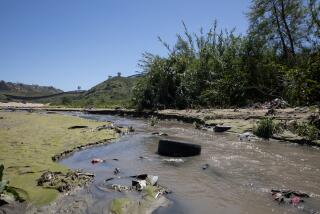Tijuana River’s polluted flows cast international spotlight on border pump station
Reporting From TIJUANA — The operation of a small pump station near the U.S. border has become a matter of growing international concern.
The station, known as PB CILA, prevents dry-weather water flows in the Tijuana River channel from crossing to the United States. The station shuts down when rains that raise the channel’s volume overwhelm the pumps’ capacity — and the result is the flow of polluted water to the coastline on both sides of the border.
“It’s the age-old story. Water’s contaminated and the beaches are closed,” said Steve Smullen, area operations manager for the U.S. section of the International Boundary and Water Commission, or IBWC.
The subject of polluted cross-border flows in the Tijuana River watershed for decades has been a recurring theme in the San Diego-Tijuana region and the subject of much binational collaboration. In October, a U.S.-Mexico agreement, Minute 320, established a new framework for cooperating on the issues of sediment, trash and polluted storm water in the watershed.
Last month, 18 nonprofit groups in San Diego cited the agreement in a letter to the IBWC’s U.S. commissioner, Edward Drusina, urging a solution and demanding improvement in the operation and management of the station.
The contaminated flows “pose a threat to public health of San Diego-Tijuana border residents,” says the letter, whose signers included the Imperial Beach environmental group Wildcoast, the San Diego Audubon Society, the Tijuana Sloughs Surf Club and the chambers of commerce of San Ysidro, Imperial Beach and Coronado.
In the letter, the groups call for the establishment of a new binational agreement detailing “when the PB CILA pump station should be operational and when ... it should be turned off.” The letter says that “during past rain events, the station has been turned off during periods longer than needed.”
Near the U.S. border, PB CILA is operated by Baja California’s State Public Service Commission. The station is easy to miss, as it sits behind a chain-link fence and is often hidden by the giant red trucks parked outside Tijuana’s main fire station. Yet for a quarter of a century, it has played an important role in keeping beaches clean on both sides of the border.
PB CILA was built after Minute 283, a 1990 agreement between the United States and Mexico that says “the government of Mexico will assure that there are no discharges of untreated domestic or industrial wastewaters into waters of the Tijuana River that cross the international boundary.”
The agreement also led to the construction of the South Bay International Water Treatment Plant, which treats sewage from Tijuana and sends it to the Pacific Ocean.
But although these measures have largely served to contain polluted cross-border flows under dry weather conditions, the problem persists when it rains.
The issue with PB CILA involves water sent down the concrete channel of the Tijuana River for discharge into the Pacific at Punta Bandera, Mexico. This volume has grown in recent years, as new sewage treatment plants upstream discharge their treated water into the channel, where it blends with runoff and some untreated waste water from nearby colonias. In dry weather, the channel’s flow is about 13 million gallons a day, according to the State Public Service Commission.
PB CILA’S pumps are turned off when rains raise the volume in the channel above 1,200 liters a second, about 27 million gallons a day, said Juan Tamayo, the service commission’s deputy director for water treatment in Tijuana.
Tamayo said that whenever his workers turn off the pumps — and when they turn them back on — the state agency notifies Mexico’s counterpart of the IBWC. It is then up to Mexican federal officials to notify the IBWC.
The station doubled its capacity more than a decade ago — from three pumps to six pumps, he said in an interview Friday. “There has been no change. On the contrary, we’ve improved.”
There has been no malfunction of the pump station in recent months, Tamayo said. But some unseasonal rainstorms over the last year have resulted in the station’s shutdown at unusual times, “as a result of climate change,” Tamayo said.
Sandra Dibble writes for the San Diego Union Tribune.
More to Read
Sign up for Essential California
The most important California stories and recommendations in your inbox every morning.
You may occasionally receive promotional content from the Los Angeles Times.










